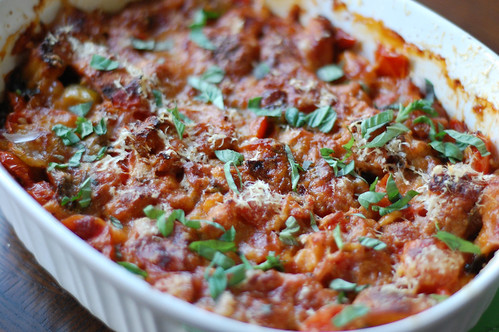This style of gumbo is definitely more
Savannah/Charleston than the Louisiana styles most of y'all are probably used to. I was introduced to this style initially growing up at one of the many family reunions we'd attend. Family reunions in the south are big affairs: everyone shows up about mid-morning if it's on a Saturday, or just after church if it's on a Sunday, and brings whatever they had decided to cook that day. Big folding tables are set up out in the yard of whomever's house was the fortunate (or unfortunate ;)) one to be hosting - although sometimes we'd end up renting a public park or such. Then the dishes would just be scattered all over the tables - a cornucopia of roasted meats, fried things, stews, soups, vegetables, salads, casseroles. Gumbo of this style would be in a big pot, usually right next to another southern classic, Brunswick Stew (which I promise I'll share my recipe for soon). All of us kids would usually get first dibs at the tables. This was so we'd get all full of energy to run around and play for the rest of the afternoon while the adults sat around gossiping and telling stories.
I was re-introduced to this style of gumbo on a visit to Savannah about 15 years ago. Ever since, this style has stuck. I found the basics of a recipe in an old
Edna Lewis cookbook with some cross-referencing to New Orleans Chef
Paul Prudhomme's cookbook and fiddled with it until I got it to what I remembered. So, this is now how I make gumbo. Now, I admittedly don't always make it the same exact way every time - which is kinda the beauty of this dish. Sometimes I leave out the oysters or scallops because I can't find ones I like. Sometimes I add pulled chicken that I had leftover from earlier in the week. However, the recipe below is the one I most often use and matches closest to my memories. I hope y'all enjoy.
Lowcountry Gumbo
Ingredients
2 sticks of unsalted butter
1 1/4 cup of all-purpose flour
1 bottle of good dry white wine (Sauvignon Blanc or Pinot Grigio)
3 quarts of chicken stock
1 lb. of mild pork sausage, ground or diced
1 lb. of ham (off the bone preferred, but ham steaks are OK), diced
1 lb. shrimp, peeled, detailed, deveined, chopped
1 lb. scallops, chopped
1 lb. jumbo lump crab meat (if fresh is unavailable, a good refrigerated brand OK)
1 lb. mild whitefish filets (grouper, flounder, cod, halibut all acceptable), cut into small pieces
1/2 lb. oysters (this is weight after shucking - if fresh is unavailable, a good canned or refrigerated brand is OK), chopped
2 large red bell peppers, diced
1 large green bell pepper, diced
2 large sweet onions, diced
1 whole celery stalk (ribs removed), diced
6 large green heirloom tomatoes OR 10 green vine tomatoes, diced
1 small can (16 oz.) crushed red tomatoes
2 1/2 lbs. of frozen cut okra (usually 2 bags)
1 1/2 tbsp. celery salt
1 1/2 tbsp. cayenne pepper
1 1/2 tbsp. smoked paprika
1 tbsp. white pepper
1 tbsp. black pepper
1 tbsp. savory
1 tbsp. ground sage
1 tbsp. sugar
5 bay leaves
1 bunch of scallions, diced (for garnish)
6 cups of cooked long-grain white rice (because you can't have gumbo without rice :))
Directions
You will need a large 18 quart stockpot for this recipe. Over medium-high heat, add butter, sausage, and ham to pot. Cook until sausage is fully cooked and browning, stirring frequently with a big wooden flat spatula, approximately 10 minutes. Remove cooked sausage and ham with a slotted spoon to a separate plate or bowl leaving all rendered fat in the bottom of the stockpot. Now it's time to roux.
Keep heat at medium-high. Stir all of the flour into the fat. Using the spatula, keep stirring constantly at a slow, gentle pace until the roux reaches a medium brown (caramel) color. This can take anywhere from 10 - 15 minutes. Once you've hit color, immediately add back the pork, ham, chopped celery, onions, and bell peppers. Keep stirring until the vegetables start to sweat (about 4 - 5 minutes). Slowly add in 1/3 of the bottle of white wine at a time, stirring until fully incorporated. Now add all dry seasonings, the bay leaves, and frozen okra. Stir to incorporate. Now add all chicken stock. Bring to a boil, stirring occasionally, then reduce heat to a low simmer. Stir occasionally and deep into the pot (to prevent any sticking) about every 4 - 5 minutes.
After 45 minutes of cooking, use a spoon to test for seasoning - adjust if you'd like (if too spicy for you, add a little more sugar). Now add the green and canned crushed tomatoes to the pot. Continue cooking for an additional 30 minutes, stirring about every 4 to 5 minutes. Gumbo should reach a thickness somewhere in between a soup and a hearty stew. If it's not thick enough for you, whisk 1 to 2 tbsp. of cornstarch into some hot water to make a slurry then add to the pot to thicken things up.
Now add all of the diced and chopped seafood to the pot. Continue cooking for an additional 30 - 45 minutes. All seafood should be cooked through and the gumbo should now have a solid and good seafood-forward taste. Remove pot from heat.
Use a ladle to fill bowls approximate 3/4 of the way to the top. Add 1/4 to 1/3 cup of cooked white rice to the center. Sprinkle chopped scallions liberally over the top and serve.
(makes 16 - 24 servings.)





















